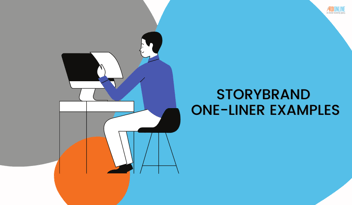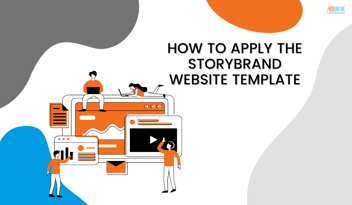Get Started On Your StoryBrand Worksheet
StoryBrand has lots of worksheets that can help you clarify your message, but in this article, we'll dive into one - the BrandScript.
The BrandScript follows Donald Miller's StoryBrand Framework, which takes the elements of a story and incorporates them into your brand's messaging. Before you can tell a story with your marketing message, Miller teaches us to use BrandScript to build the foundations first.
Your BrandScript can be your brand's guide whenever you're creating copy, a website, emails, or simply interacting with your customer in any medium.
How This StoryBrand Worksheet Can Help Clarify Your Marketing Materials
Have you ever tried to read bad pitches about marketing approaches? You know, those articles or pamphlets or flyers that are supposed to make your marketing campaign more understandable and relatable.
If the marketing materials look long, detailed, and boring, you probably either tossed it in the trash without finishing, or you crammed it in your briefcase thinking you'll get to it later.
Unlike those unnecessarily long marketing approaches, your BrandScript will help you create marketing messages that are clear, concise, and easy to understand. It uses a story structure so customers understand it and want to know more!
Most companies don't follow the storytelling structure we know and love. They try to talk about themselves and how they got this or that award without identifying with their customers.
What BrandScript does is peel off the proverbial layers in your marketing, ask the questions that matter to your business' growth, and make your messaging simple.
How Did Donald Miller Use Stories in Marketing Materials?
Donald Miller, the author of Building a StoryBrand was once a memoirist. After years of working with people who have stories to tell, he discovered that a lot of the greatest stories in the world have common elements within them. He then sat down and created the StoryBrand Framework, a 7-part roadmap every great story follows.
He discovered that the reason why we love listening, reading, or watching stories is that we can relate to the main character's struggle and quest to achieve a transformation from being someone who lives with a problem, looking to achieve a better life to someone who lives in an improved status quo, a happy ending! Donald Miller learned how the Storybrand Framework could be used to help businesses tell better stories so that their audience can easily understand and relate to what they're trying to convey.
Donald Miller realized that marketing doesn't just have to be pretty pictures and slogans, but that it could actually be a story that audiences can empathize with and connect with on an emotional level. Donald Miller said, "Every product or service in the world is part of someone's personal story."
Donald Miller told a story about how he witnessed people bonding over their deeper connection with his marketing materials. He explained how his friend, an architect, changed the way he communicated his ideas to clients by using the Storybrand Framework. Donald Miller said that most of us make big decisions based on emotion and then we add some logic into the mix to justify that decision.
Miller also noticed people tend to be more loyal and engaged when they're emotionally attached. Donald Miller learned how important it is for business owners to understand this so he created the StoryBrand Framework to help business leaders like you tell better stories.
Since the release of his book, Building a StoryBrand, Miller has helped businesses, brands, and even nonprofit organizations clarify their message and capture their audience's focus. This is the result that we want to achieve in this StoryBrand worksheet.
Let's dive into the parts of a BrandScript so you can start creating messages that your customers will love to pay attention to.
Define What Your Potential Customers Want
Every time a potential customer visits your website or your social media pages, they're already looking for a solution - this is where your brand story begins.
The hero's journey is the building block of many great stories and brands, too. The hero's journey is the model used in marketing and branding because it's designed to create interest in your customer's mind.
Every potential customer has a hero inside them. They always want to be the hero of their own story. Every potential customer wants to be your brand hero - they're hoping that your brand can give them the tools and skills to become successful, whatever success is for them. Real potential customers are ever-curious, always wondering, "Where can I find somebody to give me my next skillset?"
They're looking for the newest, most innovative way to solve their problem. They want someone who has already done it before them - they are your potential customer. Your brand mission is to give your customers the tools and abilities needed in order for them to succeed.
In this part of the BrandScript, your mission is to define the wants and needs of your customers. In their minds, what can actually be attributed as wants turn into needs.
Define who your potential customer is and what they want to do.
How Will You Solve Their Problem?
.png?width=1200&name=84335%20-%20Get%20Started%20On%20Your%20StoryBrand%20Worksheet%20(2).png)
People don't care about your customer service awards or how much customer feedback you receive. The only reason why they're even on your website or on your social media pages is because they have a problem and they're trying to find out if you can help.
When we communicate this point clearly to our customers, we begin to connect with them at an emotional level. We connect with customers because they find out that we are not only aware of the problem, we also know that their problem exists below the surface.
Your customer's problem has three layers - external, internal, and philosophical. The external problem is the one blocking their way forward. Internal problems define how they feel about the problem. The philosophical problem asks why it is wrong to have this problem.
Your mission in this part of the BrandScript is to define the external problems your customers are facing. What kind of external problem does your business solve? Let's take printers for example.
External problem
If you sell printers, your customer's external problem would be the lack of a hard copy. They need photocopies of this or that and without a good printer, they won't get what they desire.
Internal problem
In this case, the internal problem would be the frustration they feel whenever they want a copy of something handed to somebody. If you go deeper, you'll be solving the need for an entire office to be informed about memos or scripts.
Philosophical problem
It's dead wrong to have this kind of problem in the office because it shouldn't be too much to ask for a printed copy of a document - this is the philosophical problem.
Take this context and apply it to what your business seeks to solve.
How To Communicate Your Brand's Empathy and Authority
Your customers need guidance to feel like they're making progress on their journey. If you don't communicate empathy and authority to your hero, your customer isn’t going to listen.
Empathy
Empathy is all about listening to their problems, then showing them how you can help solve that problem. Authority is letting them know you've helped others like them before and you can bring them the confidence they need to achieve success.
Now that we know the guide's role, let's look at how you can communicate empathy and authority.
Empathy is communicating that you understand your customer's problem.
Show them that you understand their pain, tell them about what they're feeling. To communicate empathy in your guide, tell a story about someone who's gone through the same pain they are experiencing now.
It’s not enough to tell them about someone else's journey, you've got to give data points too. Give them facts that back up how deeply they might be feeling the pain they are through. Showing empathy means seeing what your hero can't see themselves.
Your customer needs to know that you're the one they need to trust. The story of empathy is important, but if your hero doesn't feel confident in your brand's ability to help them through the journey, it won't work.
Authority
To communicate authority is to show your customer that you've been in their shoes and you can bring them the confidence they need to make it through.
Show your customer how many times you've helped others like them before and how much trust is placed in you by those who've succeeded. Let them know that they're not alone and the guide has been here before.
To summarize: empathy is listening to what your hero's feeling and telling a story about someone who felt the same pain. Authority means letting them know how many times you've helped others in their shoes successfully succeed in their journey.
Give Them a Summary of Your Plan
It's not enough to be the perfect solution for your customer's problem. If you want to win more business, you need to make it easy for customers to do business with you. Once they decide that you're too complicated to work with, it gets even harder to win them back.
When customers are looking for a solution, it's more likely that they'll be persuaded by brands with a clear plan. That plan isn't just the price of your product or service; you also need to include how long it will take them to get started and what plan they'll follow when they do.
The plan isn't the most exciting part of your business, but it's what makes customers feel comfortable with you. If it's too complicated, then plan on losing business. It's that simple.
If you're not sure how to plan out the possible moves for your brand, here are some good places to start:
- Start with a plan summary: This helps you identify the important points that need to be addressed in your plan.
- When possible, plan out familiar steps: Customers like to see that you plan for something they've done before (like creating a blog or marketing plan).
- Keep it simple: The plan doesn't have to be complicated, but it does have to be clear for all parties involved.
"Building a StoryBrand" by Donald Miller teaches us to create a 3-step marketing plan - a summary of instructions on how safe and easy it is for your customers to move forward with your business. In this part of the StoryBrand BrandScript, sum up your company's solution delivery process in just three steps. You can go as high as four, but anything beyond that cannot be easy to do.
Call Them to Action
When a customer knows that your brand's solution is easy, safe, and perfect for their problem, it's time for you to call them to action.
In your website or marketing copy, this call manifests itself in the Buy Now or Schedule a Call buttons at the bottom of your page or email.
Customers that are ready to respond will click on your Direct CTAs. For those who want to know more about your brand, give them a Transitional CTA, a next step that gives them more information about how your solutions are made for their problems.
Your call to action has to be clear. You know that button has gotten the job done before, so why not put it on your site again? Apparently, because you're cashing in on false confidence. When you're setting up your call to action, keep clarity in mind. A complicated CTA can bring in more objections and questions in your customer's mind.
In this section of the StoryBrand BrandScript, answer this question - what's the next step my customer should make? For Transitional CTAs, ask - which information can I provide that would make my solutions clearer for my customer?
Alternative Endings: Tragic Failure or Successful Result
Before the hero's journey ends, the path will go on a fork, giving you two alternate endings - failure or success.
In this part of the StoryBrand BrandScript, your mission is to paint a picture for your customer of how their journey ends. Will they continue to live with their problems and face failure? Or will they choose you as their guide and live a better life?
As you write your marketing copy, try not to focus on failure. Instead, make sure you tell your customer what they will achieve.
Reflect on the success they will have and how their life will improve. Close it by mentioning where they can find success and what it will cost them if they choose to live with failure.
Start Working and Applying Your BrandScript
If you're ready to get to work, consider joining the next StoryBrand Workshop.
In this interactive, two-day workshop, you'll work with StoryBrand Certified Guides and they will help you create the BrandScript for your business. Stop getting lost in all the competition and start standing out - it all starts when you're carrying the right message in front of your ideal customers.
Sign up today and save your spot on the next StoryBrand Workshop.
Click here for more valuable information!





